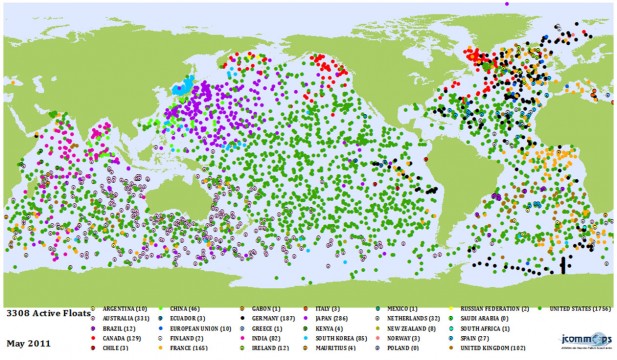
NOAA scientists use data from some of the floats in the Argo array to monitor changes in ocean chemistry. Credit: NOAA
Scientists can now remotely monitor the ocean’s changing chemistry with help from some of the five-foot-tall Argo floats that drift with deep ocean currents and transmit data via satellite back to land. A new and innovative method shows how readings of the acidity (pH) and total carbon dioxide (CO2) content of seawater can help scientists understand changes in the chemistry of the world’s ocean.
A U.S.-based research team and their Canadian colleagues developed the new approach by determining the relationships between seawater temperature, oxygen, pH and CO2 from observations collected on previous ship-based expeditions in the region in the last five years. These relationships were then applied to high-resolution observations of temperature and oxygen collected by an Argo float deployed in the North Pacific in early 2010.
“Most observations have been taken by scientists aboard specialized research ships, so this represents a major step forward in the ability to monitor ocean chemistry at higher frequency and lower cost,” said Dr. Lauren Juranek, University of Washington Joint Institute for the Study of Atmosphere and Ocean (JISAO) oceanographer and the study’s lead author.
The journal Geophysical Research Letters published the new method on Sept 2. The authors are from NOAA’s Pacific Marine Environmental Laboratory in Seattle, JISAO, and colleagues from the Department of Fisheries and Oceans in British Columbia and Quebec, Canada.
To determine pH and total CO2 content, scientists need measurements of dissolved oxygen concentration; about 10 percent of the floats have the sensors that can measure dissolved oxygen.
The profiling Argo floats used in the study are part of the international Argo observing network. The floats have been deployed by researchers in over 30 countries and approximately 3,000 active floats are distributed throughout the global ocean at any time.
The bright yellow floats ride the ocean currents, descend into the water column down to 3,000 or even 6,000 feet and as they rise to the surface after about 10 days, collect temperature, salinity, and other data that are then transmitted via satellite when the float reaches the water’s surface. Each float acquires 200 profiles over a five-year lifetime.
“These measurements can be used to complement traditional ship-based observations, not replace them. Because we can’t sample as frequently as we would like to, this approach allows us to provide repeat data on 10-day intervals,” said Richard Feely, a NOAA senior scientist and a coauthor of the study. He noted that ship-based work is still essential for calibrating the Argo float data for pH and total CO2 concentrations.
“Autonomous profiling systems, such as the Argo floats, give us a new perspective on ocean physics and chemistry, and a more comprehensive deployment of chemical sensors in the ocean interior will provide a much more complete view of the ocean carbon system,” Feely said.
The ocean’s absorption of CO2 causes the level of acidity in seawater to rise. This process, called ocean acidification, can have adverse effects on organisms that form calcium carbonate shells, such as corals, mussels, oysters, and feed stock for salmon like pteropods. The NOAA scientists and researchers at the University of Washington will continue investigating how organisms are impacted by these conditions.
Click here for more information.
On the Net: